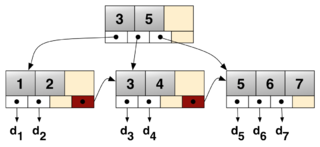XFS is a high-performance 64-bit journaling file system created by Silicon Graphics, Inc (SGI) in 1993. It was the default file system in SGI's IRIX operating system starting with its version 5.3. XFS was ported to the Linux kernel in 2001; as of June 2014, XFS is supported by most Linux distributions, some of which use it as the default file system.
ext3, or third extended filesystem, is a journaled file system that is commonly used by the Linux kernel. It used to be the default file system for many popular Linux distributions. Stephen Tweedie first revealed that he was working on extending ext2 in Journaling the Linux ext2fs Filesystem in a 1998 paper, and later in a February 1999 kernel mailing list posting. The filesystem was merged with the mainline Linux kernel in November 2001 from 2.4.15 onward. Its main advantage over ext2 is journaling, which improves reliability and eliminates the need to check the file system after an unclean shutdown. Its successor is ext4.
The Unix file system is a file system supported by many Unix and Unix-like operating systems. It is a distant descendant of the original filesystem used by Version 7 Unix.
tmpfs is a temporary file storage paradigm implemented in many Unix-like operating systems. It is intended to appear as a mounted file system, but data is stored in volatile memory instead of a persistent storage device. A similar construction is a RAM disk, which appears as a virtual disk drive and hosts a disk file system.
In computing, the Global File System 2 or GFS2 is a shared-disk file system for Linux computer clusters. GFS2 differs from distributed file systems because GFS2 allows all nodes to have direct concurrent access to the same shared block storage. In addition, GFS or GFS2 can also be used as a local filesystem.
NILFS or NILFS2 is a log-structured file system implementation for the Linux kernel. It is being developed by Nippon Telegraph and Telephone Corporation (NTT) CyberSpace Laboratories and a community from all over the world. NILFS was released under the terms of the GNU General Public License (GPL).
Data scrubbing is an error correction technique that uses a background task to periodically inspect main memory or storage for errors, then correct detected errors using redundant data in the form of different checksums or copies of data. Data scrubbing reduces the likelihood that single correctable errors will accumulate, leading to reduced risks of uncorrectable errors.
The following tables compare general and technical information for a number of file systems.

FreeNAS is a free and open-source network-attached storage (NAS) software based on FreeBSD and the OpenZFS file system. It is licensed under the terms of the BSD License and runs on commodity x86-64 hardware. FreeNAS supports Windows, macOS and Unix clients and various virtualization hosts such as XenServer and VMware using the SMB, AFP, NFS, iSCSI, SSH, rsync and FTP/TFTP protocols. Advanced FreeNAS features include full-disk encryption and a plug-in architecture for third-party software.
The ext4 journaling file system or fourth extended filesystem is a journaling file system for Linux, developed as the successor to ext3. It is the default file system for most Linux distributions.
Btrfs is a file system based on the copy-on-write (COW) principle, initially designed at Oracle Corporation for use in Linux. Not to be confused with BitTorrent File System, BTFS. The development of Btrfs began in 2007, and since November 2013 the file system's on-disk format has been marked as stable.

In Unix and operating systems inspired by it, the file system is considered a central component of the operating system. It was also one of the first parts of the system to be designed and implemented by Ken Thompson in the first experimental version of Unix, dated 1969.
Resilient File System (ReFS), codenamed "Protogon", is a Microsoft proprietary file system introduced with Windows Server 2012 with the intent of becoming the "next generation" file system after NTFS.

OpenZFS is an umbrella project aimed at bringing together individuals and companies that use the ZFS file system and work on its improvements, aiming as well at making ZFS more widely used and developed in an open-source manner.
HAMMER2 is a successor to the HAMMER filesystem, redesigned from the ground up to support enhanced clustering. HAMMER2 supports online and batched deduplication, snapshots, directory entry indexing, multiple mountable filesystem roots, mountable snapshots, a low memory footprint, compression, encryption, zero-detection, data and metadata checksumming, and synchronization to other filesystems or nodes.
bcachefs is a copy-on-write (COW) file system for Linux-based operating systems. Its primary developer Kent Overstreet first announced it in 2015, and efforts are ongoing to have it included in the mainline Linux kernel. It is intended to compete with the modern features of ZFS or btrfs, and the speed and performance of ext4 or XFS.
Stratis is a userspace Configuration daemon that configures and monitors existing components from Linux's underlying Storage components of LVM volume management and XFS file systems via DBus. Stratis is NOT user level file like (FUSE) system. Stratis Configuration daemon was originally developed by Red Hat to be feature parity with zfs and Btrfs. The hope was due to Stratis Configuration daemon in user land, it would more quickly reach maturity vs the years of kernel level development of file systems zfs and btrfs. As it is built upon enterprise tested components LVM and xfs with a over a decade of Enterprise deployments and the lessons learned from System Storage Manager in rhel7.





